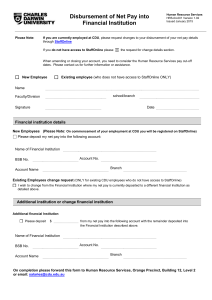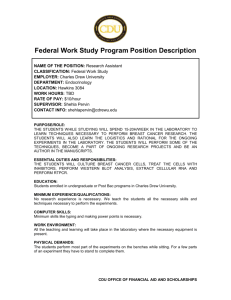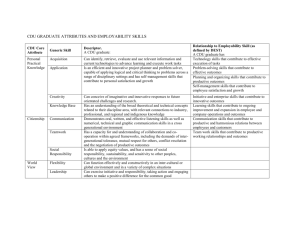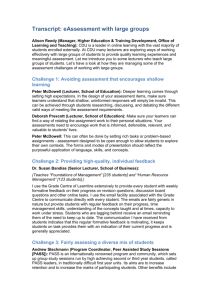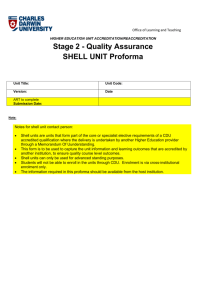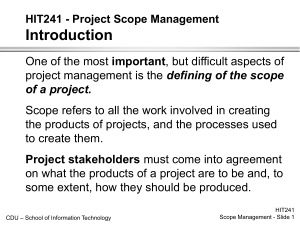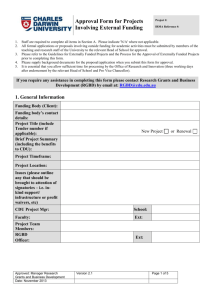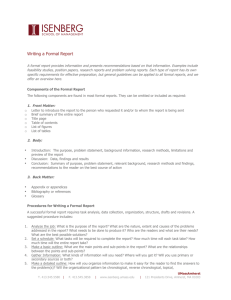ACADEMIC LANGUAGE AND LEARNING SUCCESS PROGRAM
advertisement
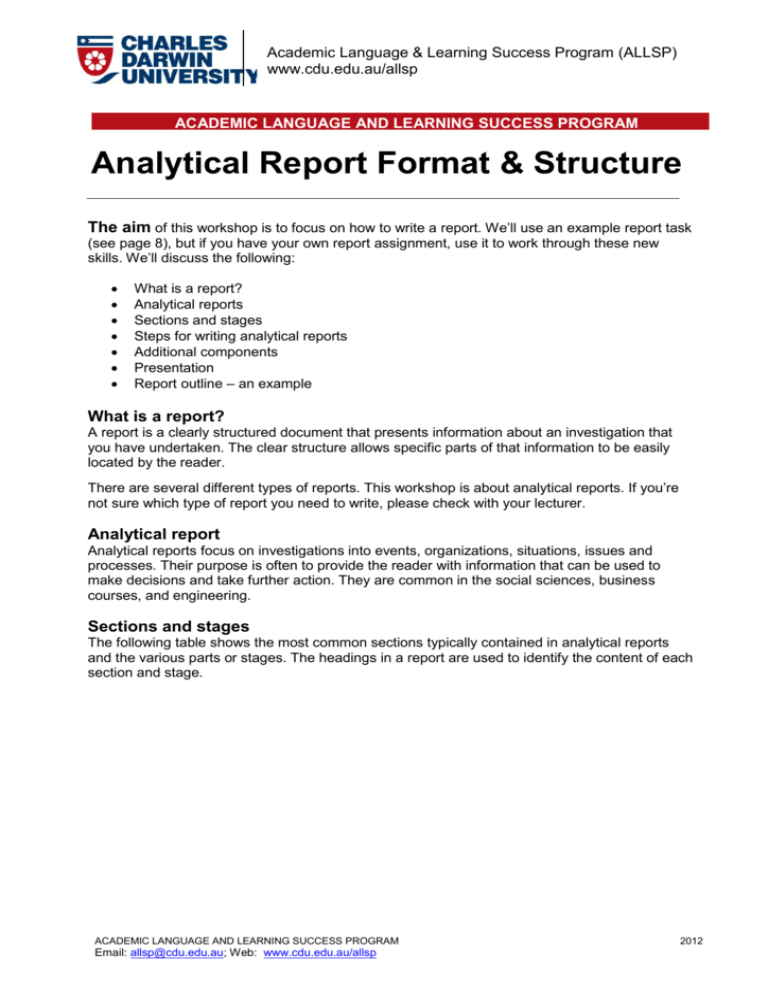
Academic Language & Learning Success Program (ALLSP) www.cdu.edu.au/allsp ACADEMIC LANGUAGE AND LEARNING SUCCESS PROGRAM Analytical Report Format & Structure The aim of this workshop is to focus on how to write a report. We’ll use an example report task (see page 8), but if you have your own report assignment, use it to work through these new skills. We’ll discuss the following: What is a report? Analytical reports Sections and stages Steps for writing analytical reports Additional components Presentation Report outline – an example What is a report? A report is a clearly structured document that presents information about an investigation that you have undertaken. The clear structure allows specific parts of that information to be easily located by the reader. There are several different types of reports. This workshop is about analytical reports. If you’re not sure which type of report you need to write, please check with your lecturer. Analytical report Analytical reports focus on investigations into events, organizations, situations, issues and processes. Their purpose is often to provide the reader with information that can be used to make decisions and take further action. They are common in the social sciences, business courses, and engineering. Sections and stages The following table shows the most common sections typically contained in analytical reports and the various parts or stages. The headings in a report are used to identify the content of each section and stage. ACADEMIC LANGUAGE AND LEARNING SUCCESS PROGRAM Email: allsp@cdu.edu.au; Web: www.cdu.edu.au/allsp 2012 Academic Language & Learning Success Program (ALLSP) www.cdu.edu.au/allsp 2 Table 1: Sections and stages of a report and the headings used Sections Stages Preliminary Section – provides the context and background information Headings for Analytical Reports Title Page Table of Contents Executive Summary Main Section or body of the report – presents the key aspects of the report: what was done, what was found, what this means Stage 1 Introduces this section Introduction Stage 2 Presents the findings and your analysis of these Headings identifying the aspect dealt with in each subsection Stage 3 States the implications of the findings and analysis Conclusions Supplementary Section – contains extra information Recommendations References Appendices Steps for writing analytical reports Step 1: Consider both your word count and your time frame The word count only refers to the main section of your report. The Executive Summary, Appendices and Reference List are not normally included in the word count. What word count has your lecturer asked for? …………………………… Plan in advance how much time you have available to research and complete your report. You may find it helpful to draw up a timeline and set planning goals. What is your due date? …………………………………. Step 2: Analyse your topic carefully In analysing your topic, you can ask yourself a series of questions: Who is the intended audience for the report, and what do they want to know? What exactly are you required to report about? To help identify what is required, underline or highlight the key words in the topic. These tell you what content to focus on in your research. What is the purpose of the report? Some purposes are to record, to inform, to instruct, to analyse or to persuade in relation to a particular issue. What is the purpose in this particular case? ………………………………………….. What is the scope of your report? What aspects of the topic are you to cover? What are the limits of the report (besides the word count and time you have available)? How is your topic limited? Is it confined to a particular place, time or group? ACADEMIC LANGUAGE AND LEARNING SUCCESS PROGRAM Email: allsp@cdu.edu.au; Web: www.cdu.edu.au/allsp 2012 Academic Language & Learning Success Program (ALLSP) www.cdu.edu.au/allsp 3 Step 3: Make an initial plan To develop your initial plan: Brainstorm your ideas. Develop a technique for doing this effectively - for example, by mind mapping or by asking questions such as What? Who? Where? When? How? Why? ...in relation to your topic. Select the ideas relevant to the aims of your report and to the questions your lecturer wants answered. Organise these ideas into a preliminary plan, grouping related ideas together into headings and sub-headings. Step 4: Locate your information and take notes Consider how best to investigate your topic. For example, do you need to draw your information mainly from journal articles or books? Seek guidance from the librarian who specialises in your discipline. Gather the information you require, keeping in mind the aim of your report. Record the sources of your information, including full bibliographic details, in a systematic way. Step 5: Prepare the first draft The main section is usually the best place to start. Once you have written that, you can go on to write the other two sections. The main section Suggestions for drafting the various stages of the main section are given below. The order you write these in is not necessarily the order given here. Start on the section you feel most confident about writing. Stage 1: Introduction The purpose of the Introduction is to orientate your reader to the whole document, and to give your report a context. You can do this by including: a clear statement of purpose – why this topic is being investigated? background to the report – why was the report requested and by whom? scope and limits of the report – what issues are covered in it, what issues are not covered and why? the methods of investigation – how did you investigate this topic? You may also include: a brief reference to the theories or ideas which you intend to discuss in more detail in your findings. Note that in larger reports these theories and ideas can form a separate section within the main body called the Literature Review a definition of any relevant terms an outline of the structure of the report Stage 2: Presentation of the findings and analysis Stage 2 is central to your report as it includes both the presentation and the analysis of your findings. Here you describe what you found out from your investigation, and analyse what those findings mean. You may find the following suggestions helpful in writing Stage 2: Adapt your preliminary plan if necessary to organise your ideas under headings and subheadings Be clear about what points you want to make to report your findings. Put what you consider to be the most important points first, followed by those of lesser importance. ACADEMIC LANGUAGE AND LEARNING SUCCESS PROGRAM Email: allsp@cdu.edu.au; Web: www.cdu.edu.au/allsp 2012 Academic Language & Learning Success Program (ALLSP) www.cdu.edu.au/allsp 4 Support each of these points with relevant evidence, elaboration or explanation. Add any diagrams (eg. graphs, tables, figures, etc) to support and present your material visually. Each diagram must have a title, and be numbered consecutively Analyse the meaning or significance of your findings. This involves pointing out the findings that most strongly answer the question/s you were investigating. You may relate the findings to the expectations you had, based on theory and the findings of other investigations. This analysis requires the skills of critical analysis (your voice). There is a workshop available to learn this skill – see http://www.cdu.edu.au/lba/all/allsp/student-info.html for details. Stage 3: Conclusion and Recommendations The purpose of the Conclusion is to restate in a shortened form the most significant outcomes from your investigation and analysis and to make a general statement about their connotation. This prepares the reader for any recommendations you make. Note that no new information should be included in this section. The purpose of the Recommendations section is to make suggestions about the action(s) or future direction(s) that should be taken as a result of your conclusions. These should be written in order of priority. Note that in some reports, the recommendations are presented as part of the Conclusion. This allows any recommended action to follow directly on from the conclusion. Which format do we need for this assignment? In either case, all recommendations should follow logically from the conclusions you have made. The Supplementary section This comprises additional information that allows the reader to verify your sources and check more detailed data. Reference List This contains a list of all the sources you have cited in the text of your report. Appendices The Appendices contain any supplementary materials you have used to gather your information such as articles, brochures, statistics, spreadsheets, charts, etc. They are appended to avoid too much detail in the main section of the report, which could distract from the flow of the discussion. Although they are not inserted into the report itself, it is important that they are referred to in the main section of the report. Each Appendix needs to be labelled and numbered and listed in the Table of Contents. The Preliminary section To complete the report for submission, extra information is attached before the main section. Title Page In addition to the ‘student assignment cover sheet’ that you attach to all written assignments, you also need to include an official Title Page for your report. This page should include: the title of the report your lecturer’s name, i.e. the person for whom the report has been prepared your name (or for a group report, the names of all those in the group who prepared the ACADEMIC LANGUAGE AND LEARNING SUCCESS PROGRAM Email: allsp@cdu.edu.au; Web: www.cdu.edu.au/allsp 2012 Academic Language & Learning Success Program (ALLSP) www.cdu.edu.au/allsp 5 report) the date of completion or submission the name of the unit. Table of Contents The Table of Contents outlines the different sections of the report, and shows the reader where to find them. It contains a list of all the headings, sub-headings, tables/figures, appendices, etc, and their corresponding page numbers. The Table of Contents can be generated electronically using Word. Executive Summary An Executive Summary gives the reader a general overview/summary of the whole report without them having to read the entire document. It should be able to stand alone as a separate document if required. The Executive Summary needs to be written last, because it summarises the information contained in the whole report. This section usually includes: the background to the report the purpose of the report, i.e. an explanation of why the report was required the scope and limits of the investigation including brief details of the general procedure, i.e. what was investigated, and how the investigation was conducted the important findings or results of the investigation, and the conclusions which you drew from the results, i.e. an explanation of what outcomes the investigation provided recommendations for action, i.e. suggestions for what future action needs to be taken Step 6: Evaluate your draft carefully Once you have completed your first draft check that... you have followed the guidelines in your course information booklet. Check particularly the requirements relating to word length, format, layout, presentation and referencing. your writing style is appropriate. Analytical reports are written in a formal style using relatively short sentences. you have connected your points logically, and used appropriate linking words and phrases each paragraph deals with one main idea your claims are supported by evidence, using references where appropriate your examples are relevant to the points being made you have referenced your work appropriately your grammar, spelling and punctuation are correct Presentation A significant aspect of any report is the way it is presented. The following is a general overview, in terms of sequence and format, of what to consider as you finalise your document prior to presentation. Sequence The different sections of your report will generally be put together according to the following sequence (including whatever sections are required in your assignment): Title page Table of contents ACADEMIC LANGUAGE AND LEARNING SUCCESS PROGRAM Email: allsp@cdu.edu.au; Web: www.cdu.edu.au/allsp 2012 Academic Language & Learning Success Program (ALLSP) www.cdu.edu.au/allsp 6 Executive summary Introduction Presentation of information (the findings) and analysis Conclusion Recommendations Reference List Appendices Format Use a clear and consistent system to enable the reader to readily identify the stages of your report. Common systems include headings, spacing, numerals, capital letters, dot points, bold fonts. In particular: Headings Use a maximum of three levels: one level for the major headings, one level for the subheadings, and one for further sub-headings (if needed). These different levels are indicated by different font sizes and styles. Numbering A decimal numbering system is commonly used, with single numerals (1, 2, 3,…) for the main headings, one decimal (1.1, 1.2, 1.3,…) for the second level of headings and two decimals (1.1.1, 1.1.2,…) for any third level headings. Report outline – an example An example of a report outline, given below, shows the three different sections (Preliminary, Main and Supplementary), and how the stages in the main section have been developed into three levels of numbered headings. Note that only the main section is numbered. ACADEMIC LANGUAGE AND LEARNING SUCCESS PROGRAM Email: allsp@cdu.edu.au; Web: www.cdu.edu.au/allsp 2012 Academic Language & Learning Success Program (ALLSP) www.cdu.edu.au/allsp 7 Table 2: Outline of a typical report showing sections, headings and numbering Section Heading and numbering Preliminary Section Title page Table of Contents Executive Summary Main Section: Stage 1 1.0 Introduction 1.1 Background to the initiative 1.1.1 …………………………………………….…. 1.2 ……………………………………………………. 1.3 Aims and objectives of the report Main Section: Stage 2 2.0 Key Findings and Analysis 2.1 …………………………………………………………. 2.1.1 ………………………………………………………….. 2.1.2 …………………………………………………………. 2.1.3 …………………………………………………………….. 2.1.4 ………………………………………………………………. 2.2 Analysis of findings Main Section: Stage 3 3.0 Conclusion 3.1 ……………………………………….. 3.2 ……………………………………….. 3.3 ………………………………………… 4.0 Recommendations 4.1 …………………………………………….. 4.1.1 ……………………………………………… 4.1.2 ……………………………………………….. 4.1.3 …………………………………………………… Supplementary Section Reference List Appendices Appendix I Appendix II This material has been modified from http://www.unisa.edu.au/ltu/students/study/assessment/reports.asp ACADEMIC LANGUAGE AND LEARNING SUCCESS PROGRAM Email: allsp@cdu.edu.au; Web: www.cdu.edu.au/allsp 2012 Academic Language & Learning Success Program (ALLSP) www.cdu.edu.au/allsp 8 Assignment 2: Keyed Report Due date: Thursday 16 September 2010 Length: 1500 words - Report Format Value: 30% Task From Chapter 10, Knowledge, Innovation and Cultural Change, develop a report addressing the questions posed by the case study on page 474. Comment on the manner in which executive management have gone about communicating the need for change; what does it tell you about their leadership style, how will this help/hinder achievement of their stated goals? Recommend new performance review and reward practices that will support the achievement of the company’s goals; support your recommendations. What other changes would you recommend for the company if they are to achieve their new goals? Presentation Assignments must contain a cover page and a reference list page. A minimum of three peer reviewed references (journal or conference papers) or other texts are required to support your arguments in addition to the main text book. Assessment Criteria/marks’ allocation Some elements of the assessment criteria for the written report type work are given below : Text organisation includes report structure including reference list, quality of argument, etc Content includes conceptual understanding, evidence of wide reading etc Presentation includes ease of reading, editing proof-reading, spelling, grammar, punctuation and consistent use of referencing Read the assessment criteria section at the end of this unit outline for more information. ACADEMIC LANGUAGE AND LEARNING SUCCESS PROGRAM Email: allsp@cdu.edu.au; Web: www.cdu.edu.au/allsp 2012
